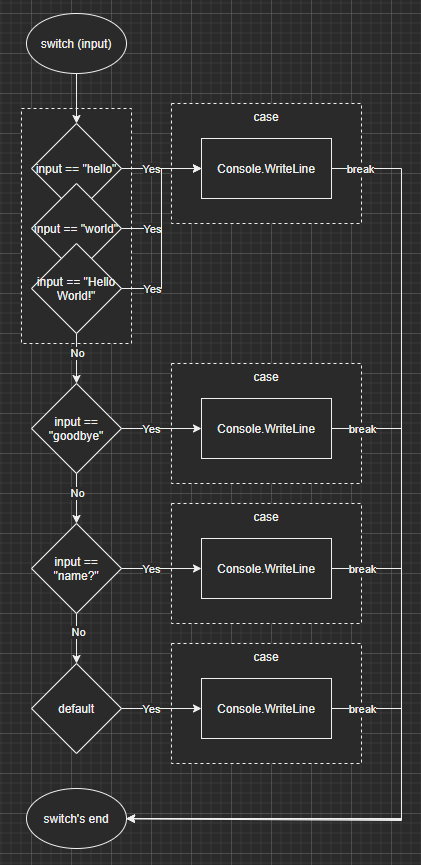This article explores how to simplify certain complex conditional blocks by introducing the switch statement.
The switch keyword is very standard in programming languages.
We use it to compare a variable with many values.
Please note that we are not covering switch expressions in this article.
This article is part of a learn programming series where you need no prior knowledge of programming.
If you want to learn how to program and want to learn it using .NET/C#, this is the right place.
I suggest reading the whole series in order, starting with Creating your first .NET/C# program, but that's not mandatory.
This article is part of a sub-series, starting with Introduction to Boolean algebra and logical operators.
It is not mandatory to read all articles in order, but I strongly recommend it, especially if you are a beginner.
If you are already reading the whole series in order, please discard this word of advice.
The Switch
In the previous article, Using if-else selection statements to write conditional code blocks, we covered the basics behind contextual code.
This article explores the switch statement by converting a complex if block to a switch.
We go through the syntax afterward.
Initial code (if):
using System;
Console.WriteLine("Enter something: ");
var input = Console.ReadLine();
if (input == "hello" || input == "world" || input == "hello world")
{
Console.WriteLine("Hello World!");
}
else if (input == "goodbye")
{
Console.WriteLine("Au revoir!"); // Goodbye in French
}
else if (input == "name?")
{
Console.WriteLine("What is your name?");
var name = Console.ReadLine();
Console.WriteLine($"Your name is {name}");
}
else
{
Console.WriteLine("Invalid input");
}
Console.WriteLine("End of the program.");
Converted code (switch):
using System;
Console.WriteLine("Enter something: ");
var input = Console.ReadLine();
switch (input)
{
case "hello":
case "world":
case "hello world":
Console.WriteLine("Hello World!");
break;
case "goodbye":
Console.WriteLine("Au revoir!"); // Goodbye in French
break;
case "name?":
Console.WriteLine("What is your name?");
var name = Console.ReadLine();
Console.WriteLine($"Your name is {name}");
break;
default:
Console.WriteLine("Invalid input");
break;
}
Console.WriteLine("End of the program.");
Let's now analyze the previous code, starting with the new keywords:
-
switch -
case -
break -
default
The switch keyword starts a code block that must be followed by a variable in parenthesis, like this:
switch (variable)
{
// Code block
}
The case keyword, followed by a value and :, is an equality comparison against the original variable passed to the switch.
You can see case "goodbye": as the equivalent of if (variable == "goodbye").
A case block can be empty or end with a break or return.
We will not cover the return keyword in this article because it is related to other concepts that we have not explored yet.
When the case is empty, it continues to the next case.
For example, case "hello": falls back to case "world": that falls back to case "hello world": that gets executed.
Interesting fact: C# does not support falling from one non-empty
caseto another as some other languages do.
The break keyword is a jump statement that allows controlling the flow of the program by exiting the current block, a.k.a. jumping out of the switch block.
Finally, in a switch block, the default keyword is the equivalent of the else; it is hit when no other case was hit.
Before the exercise, let's peek at the program flow created by a switch statement.
Flow of the program
In a nutshell, a switch statement allows comparing if a variable is equal to a value from a list of cases.
Here is a visual representation of the program flow created by a switch block:
Next, it's your turn to try it out.
Exercise
Convert the following code to use a switch statement.
var input = Console.ReadLine();
if(input == "A")
{
Console.WriteLine("1");
}
else if (input == "B")
{
Console.WriteLine("2");
}
else if (input == "C")
{
Console.WriteLine("3");
}
else if (input == "D")
{
Console.WriteLine("4");
}
else if (input == "E")
{
Console.WriteLine("5");
}
else
{
Console.WriteLine("Invalid input");
}
Once you are done, you can compare with My Solution below.
My Solution
Program.cs
var input = Console.ReadLine();
switch (input)
{
case "A":
Console.WriteLine("1");
break;
case "B":
Console.WriteLine("2");
break;
case "C":
Console.WriteLine("3");
break;
case "D":
Console.WriteLine("4");
break;
case "E":
Console.WriteLine("5");
break;
default:
Console.WriteLine("Invalid input");
break;
}
Good job! You completed another small chapter of your programming journey.
Conclusion
This article explored the switch statement, which allows comparing if a variable is equal to a value from a list of cases.
The switch statement is another way to create conditional code and control our programs' flow.
The switch statement is handy for variables with a finite number of values like enums.
More recent versions of C# also introduce switch expressions and pattern matching that open many other possibilities. However, many of those possibilities require knowledge of object-oriented programming that we are not exploring in this article series.
Please leave your questions or comments below or drop me a Tweet.
Next step
It is now time to move to the next article: Common Boolean algebra laws which is coming soon. Stay tuned by following me on dev.to, Twitter, or other places you can find me.
You can look at my blog for more info.




Top comments (0)